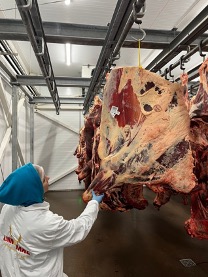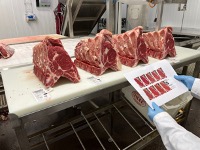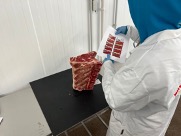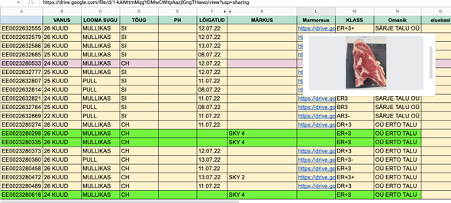
https://ec.europa.eu/eip/agriculture/en/find-connect/projects/bovine-beef-innovation-network-europe
Liivimaa Lihaveis and Linnamäe Meat Factory are bound by a partnership agreement, LL has established a grass-fed beef quality scheme with its own set of rules for the quality of animal husbandry. The animals are fattened on 100% grassland or grass forage (silage and/or hay) and Linnamäe sells and markets the animals under the LL quality scheme. There are 77 farms under the quality scheme that market their animals through the meat industry.
Consumer interest in meat of high quality has been growing, while awareness of environmentally friendly and pasture-based beef cattle production has also increased. In order to identify the intrinsic meat marbling of animals from grassland, it is necessary to map the meat marbling at the cutting table.
Estonian slaughterhouses use the EUROP system for carcass evaluation. This scoring system indicates the fat cover of the animal, but does not provide information on the amount of marbling inside meat. The long-standing cooperation between Non Profit Organisation Liivimaa Lihaveis and Linnamäe Meatfactory in the sale of animals under the grass-fed cattle quality scheme has resulted in a client base that is willing to buy higher priced cuts of stronger marbled steaks and other meat. At the same time, there is no overview of how many of the fat grades 2 - 3 and above sold are in fact intramuscular marbles according to customer preference. The aim is to map all animals carcasses of 2+ fat grading during the year, their owners and the cattle's pedigree and managament, feeding systems, age at slaughter, etc. This can be used as a basis for analysing whether it is possible to design a separate, higher-priced sales output and, at the same time, provide farmers with feedback on which animals have more intramuscular marbling, so that they can use this information to develop their own breeding and feeding and management practices to produce more intramuscular marbling.
Description of Innovation
From May 2022, the meat industry in Estonia have started mapping carcasses according to intramuscular fat content. This is done by an initial selection from all carcasses with a fat cover of 2 and above. These carcasses are cut separately, the area of muscle surface is photographed at 12-13 ribs, and marbling is mapped. All the data will be brought together in a single database with visual material. Initially they will use the Australian Ausmeat grading system as a basis. Farmers receive feedback on whether or not the animals have the right marbling within a month of the animals being cut. Feedback can be more thorough if the farmer who sold the animals is subject to a performance testing, then it is also possible to look at the pedigree of the animals.



This evaluation system was chosen because Liivimaa Lihaveis and Linnamäe are launching a Wagyu cross-breed programme from 2024, and the first F1 calves are 6 months old today, so the aim is to keep the programme consistent and develop different branding for traditional grass-fed cattle and Wagyu cross-breeds similar to Sher Wagyu . The results of this project The results of this project also imply "on-farm strategies to increase/improve beef marbling/tendernesscolour", another priority topic from BovINE project.

Impact on farm performance
This practice gives the farmer a perspective and understanding of which animals and under which grazing conditions achieve the best marbling of meat. It is important to be aware that the carcasses being mapped are those that will be cut under a grass-fed beef quality scheme, i.e. not fattened with grain and other concentrates. All the more important are the different types of livestock, slaughter ages, categories, grazing methods and the crops or natural grasslands that are grazed.
The mapping will also tell us how much potential there is in our conditions to produce high-marbling meat in the first place, and the marketing methods can be decided on the basis of this. The mapping is free of cost for the farmer.
Farmer comment (for Good Practices)
„We know that customers and consumers want marbled meat. At the same time, however, there is not always satisfaction with the current pricing system, i.e. the SEUROP classification does not always provide an equivalent picture in terms of marbling. As a farmer, I would be prepared to make changes in the way animals are kept if I knew which animals could potentially produce more marbled meat from grassland. In order to get this information,I would need feedback from the slaughterhouse on the animals that have already been slaughtered, as to what the marbling of the muscular eye is. At the moment we have SEUROP as a basis for carcass evaluation, which does not give an insight into intramuscular marbling, so this mapping of carcasses is a good starting point for making mutually satisfactory decisions in the future. The factory also needs to forecast possible marbling meat quantities and purchase prices, in case, for example, the farmer has to graze the animals for some months longer or feed them in winter longer or with different type of feed to get better marbling.“ - Lisanna Hiiemäe , Sepa Veised OÜ.
Further information
https://hub.bovine-eu.net/search/tv-commercial-for-grassfed-beef